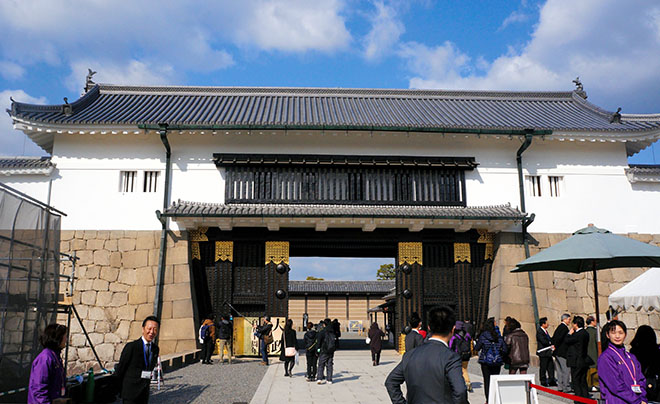Information
Nijo Castle’s gleaming gate looks as good as new after repairs
KYOTO--Nijo Castle’s main gate is looking back to its majestic best after the completion of extensive repair to the entrance of the UNESCO World Heritage site in this ancient capital.
Higashi Ote-mon (East main gate), as the structure in Kyoto’s Nakagyo Ward is called, is designated an important cultural property by the central government.
The East main gate had been redesignated the entrance and exit for castle visitors, who had to come and go through the North main gate while the work was going on.
Tourists were seen passing through the refurbished gate as soon as the giant structure, back in its splendor with golden decorative metal fittings and other features, creaked open.
Nijo Castle was built by Tokugawa Ieyasu, founder of the Tokugawa Shogunate, in 1603. The fortress underwent large-scale remodeling by Iemitsu, third shogun of the Tokugawa clan, to coincide with Emperor Go-Mizunoo’s 1626 visit to the castle during the Kanei Era (1624-1644).
The East main gate, which had been a two-storied gatehouse when the castle was first built, was restructured into a one-tier gate so that the emperor would not be looked down from above during his Kanei visit. Repair work carried out after an earthquake in 1662 gave the gate the appearance it retains to this day.
Topped with an “irimoya” (hip-and-gable) roof tiled in the “honkawara-buki” style (alternating columns of convex and flat tiles), the structure stands some 13 meters tall and 26 meters wide.
The Kyoto city government began a major renovation of Nijo Castle in fiscal 2011, the first of its kind since the fortress was built. It spent some 470 million yen ($4.3 million) on repair work on the East main gate, which began in October 2014 and included retiling, repainting of stucco walls and seismic retrofitting.
A special public viewing of the East main gate that started on March 24, preceded by a ceremony to mark the end of the repair work two days earlier, runs through July 31 to commemorate the end of its repair.
Nijo Castle’s Southeast corner turret, another central government-designated important cultural property that was built at the time of the Kanei imperial visit, is also available for special public viewing on the occasion.
Members of the public are allowed access to the interior of the East main gate, where they can see, for example, an “ishi-otoshi” (stone drop), an opening in a floor by the side of a wall through which stones could be dropped or arrows could be shot for defensive purposes.
Admission to the special public viewing is 400 yen and comes on top of the admission to enter Nijo Castle, which is 600 yen for adults.
Category: English
News
Information
Key words:

